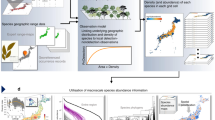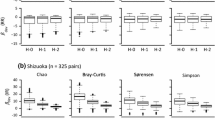Abstract
Nestedness of species assemblages occurs when thebiotas of sites with lower numbers of species tend to be subsets of the biotas at richer sites. We develop new quantitative and statistical techniques for measuring, testing, and comparing nestedness, and apply these methods to data from the literature. Significantly nonrandom nestedness was present in all 27 assemblages examined, and tended to be stronger in systems dominated by extinction, such as landbridge islands. Sets of assemblages that were very strongly nested were more likely to have greater species richness on one or a few large sites than on several smaller sites of equivalent total area — that is, to fall toward the “single large” side of the “Single Large Or Several Small” (SLOSS) continuum. Our analysis indicates that nestedness, when quantified as a single number for a presence-absence matrix, measures community-wide differences in incidence (the frequency of occurrence or “distribution” of species). Factors that lead to consistent differences among species in immigration or extinction rates cause strong patterns of nestedness of species assemblages. Nestedness is negatively related to beta diversity: nestedness is low when beta diversity is high, and vice versa. Conservation managers will thus seek to minimize nestedness and the development of nested structure in systems of nature reserves.
Similar content being viewed by others
References
Blake JG (1991) Nested subsets and the distribution of birds on isolated woodlots. Conserv Biol 5:58–66
Bock CE, Ricklefs RE (1983) Range size and local abundance of some North American songbirds: a positive correlation. Am Nat 122:259–299
Bolger DT, Alberts AC, Soulé ME (1991) Occurrence patterns of bird species in habitat fragments: sampling, extinction, and nested species subsets. Am Nat 137:155–166
Brown JH (1978) The theory of insular biogeography and the distribution of boreal birds and mammals. Great Basin Nat Mem 2:209–227
Brown JH (1984) On the relationship between abundance and distribution of species. Am Nat 124:255–279
Brown JH, Gibson AC (1983) Biogeography. C.V. Mosby, St. Louis
Brown JH, Kodric-Brown A (1977) Turnover rates in insular biogeography: effect of immigration on extinction. Ecology 58:445–449
Collins SL, Glenn SM (1990) A hierarchical analysis of species' abundance patterns in grassland vegetation. Am Nat 135:633–648
Connor EF, Simberloff D (1978) Species number and compositional similarity of the galapagos flora and avifauna. Ecol Monogr 48:219–248
Conover WJ (1980) Practical Nonparametric Statistics (2nd ed). Wiley, New York Chichester Brisbane Singapore
Cutler A (1991) Nested faunas and extinction in fragmented habitats. Conserv Biol 5:496–505
Diamond JM (1975) Assembly of species communities. In Cody M, Diamond JM (eds) Ecology and Evolution of communities. Harvard Univ. Press, Cambridge, Massachusetts, pp 342–444
Diamond JM (1984) “Normal” extinctions of isolated populations. In: Nitecki MH (ed) Extinctions. Univ Chicago Press Chicago, pp 191–246
Diamond JM, Gilpin ME (1982) Examination of the “null” model of Connor and Simberloff for species co-occurrences on islands. Oecologia 52:64–74
Gotelli NJ, Simberloff D (1987) The distribution and abundance of tallgrass prairie plants: a test of the core-satellite hypothesis. Am Nat 130:18–35
Graves GR, Gotelli NJ (1983) Neotropical land-bridge avifaunas: new approaches to null hypotheses in biogeography. Oikos 41:322–333
Griffiths TA, Klingener D (1988) On the distribution of Greater Antillean bats. Biotropica 20:240–251
Hanski I (1982) Dynamics of regional distribution: the core and satellite species hypothesis. Oikos 38:210–221
Hanski I, Kouki J, Halkka A (1993) Three explanations of the positive relationship between distribution and abundance of species. In: Ricklefs RE, Schluter D (eds) Species Diversity: Historical and Geographical Perspectives. Univ Chicago Press, Chicago, in press
Hope JH (1973) Mammals of the Bass Strait islands. Proc Roy Soc Victoria 85:163–195
Karr JR (1982) Avian extinction of Barro Colorado Island, Panama: a reassessment. Am Nat 119:220–239
Lawlor TE (1983) The mammals. In: Case TJ, Cody ML (eds) Island Biogeography in the Sea of Cortéz. Univ California Press, Berkeley, pp 265–289
Leigh EG (1981) The average lifetime of a population in a varying environment. J Theor Biol 90:213–239
Lomolino MV (1986) Mammalian community structure on islands: the importance of immigration, extinction and interactive effects. Biol J Linnean Soc 28:1–21
Magurran AE (1988) Ecological Diversity and Its Measurement. Princeton Univ Press, Princeton, New Jersey
Margules CR, Stein JL (1989) Patterns in the distributions of species and the selection of nature reserves: an example from Eucalyptus forests in south-eastern New South Wales. Biol Conserv 50:219–238
Maurer BA (1990) The relationship between distribution and abundance in a patchy environment. Oikos 58:181–189
McCulloch CE (1985) Variance tests for species association. Ecology 66:1676–1681
Meserve PL, Glanz WS (1978) Geographical ecology of small mammals in the northern Chilean arid zone. J Biogeogr 5:135–148
Nichols SW (1988) Kaleidoscopic biogeography of West Indian Scaritinae (Coleoptera: Carabidae). In: Liebherr JK (ed) Zoogeography of Caribbean Insects. Cornell Univ. Press, Ithaca, New York, pp 71–120
Patterson BD (1984) Mammalian extinction and biogeography in the southern Rocky Mountains. In: Nitecki MH (ed) Extinctions. Univ Chicago Press, Chicago, pp 247–293
Patterson BD (1987) The principle of nested subsets and its implications for biological conservation. Conserv Biol 1:247–293
Patterson BD (1990) On the temporal development of nested subset patterns of species composition. Oikos 59:330–342
Patterson BD, Atmar W (1986) Nested subsets and the structure of insular mammalian faunas and archipelagos. Biol J Linnean Soc 28:65–82
Patterson BD, Brown JH (1991) Regionally nested patterns of species composition in granivorous rodent assemblages. J Biogeogr 18:395–402
Pielou EC (1972) 2k contingency tables in ecology. J Theor Biol 34:337–352
Pimm SL, Jones SL, Diamond J (1988) On the risk of extinction. Am Nat 132:757–785
Pulliam HR (1988) Sources, sinks, and population regulation. Am Nat 132:652–661
Quinn JF, Harrison SP (1988) Effects of habitat fragmentation and isolation on species richness: evidence from biogeographic patterns. Oecologia 75:132–140
Rabinowitz D, Rapp JK, Cairns S, Mayer M (1989) The persistence of rare prairie grasses in Missouri: environmental variation buffered by reproductive output of sparse species. Am Nat 134:525–544
Robinson JV, Dickerson JEJr (1987) Does invasion sequence affect community structure? Ecology 68: 587–595
Robinson JV, Edgemon MA (1988) An experimental evaluation of the effect of invasion history on community structure. Ecology 69:1410–1417
Schoener TW, Schoener A (1983) Distribution of vertebrates on some very small islands. I. Occurrence sequences of individual species. J Anim Ecol 52:209–235
Simberloff DS (1969) Experimental zoogeography of islands: a model for insular colonization. Ecology 50:296–314
Simberloff D, Levin B (1985) Predictable sequences of species loss with decreasing island area — land birds in two archipelagoes. New Zealand J Ecol 8:11–20
Soulé ME, Simberloff D (1986) What do genetics and ecology tell us about the design of nature reserves? Biol Conserv 35:19–40
Whittaker RH (1972) Evolution and measurement of species diversity. Taxon 21:213–251
Williamson M (1981) Island Populations. Oxford Univ Press, London
Wilson MV, Shmida A (1984) Measuring beta diversity with presenceabsence data. J Ecol 72:1055–1064
Wright DH (1985) Patch dynamics of a foraging assemblage of bees. Oecologia 65:558–565
Wright DH (1991) Correlations between distribution and abundance are expected by chance. J Biogeogr 18:463–466
Wright DH, Currie DJ, Maurer BA (1993) Energy supply and patterns of species richness on local and regional scales. In: Ricklefs RE, Schluter D (eds) Species Diversity: Historical and Geographical Perspectives. Univ Chicago Press (in press)
Wright SJ (1985) How isolation affects rates of turnover of species on islands. Oikos 44:331–340
Author information
Authors and Affiliations
Rights and permissions
About this article
Cite this article
Wright, D.H., Reeves, J.H. On the meaning and measurement of nestedness of species assemblages. Oecologia 92, 416–428 (1992). https://doi.org/10.1007/BF00317469
Received:
Accepted:
Issue Date:
DOI: https://doi.org/10.1007/BF00317469




